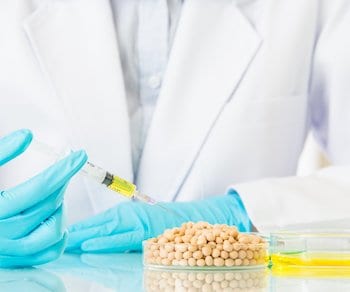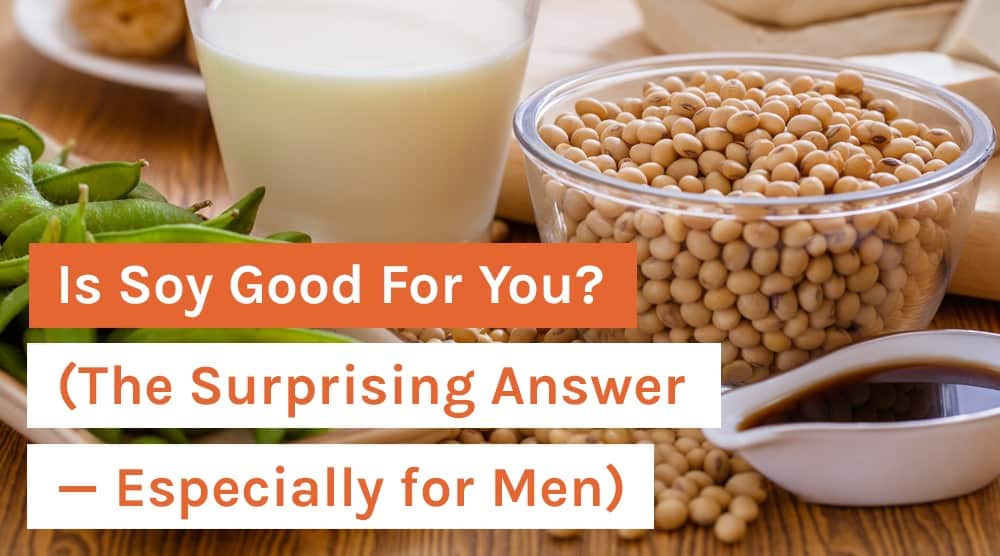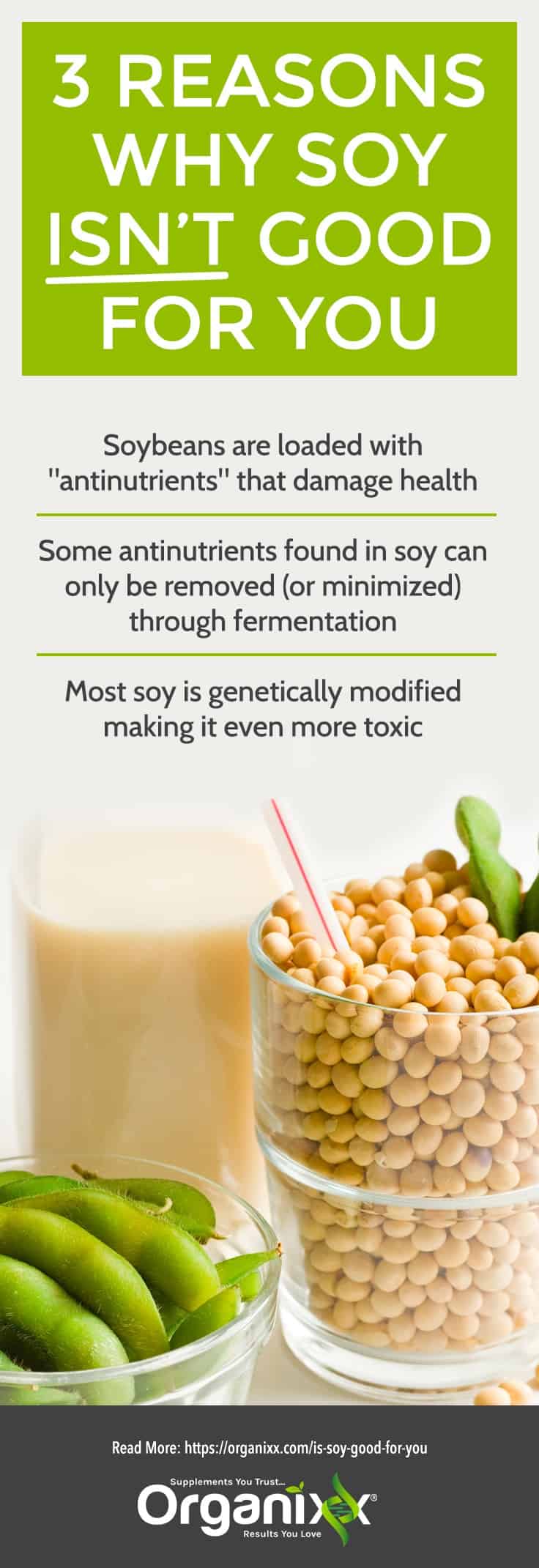Is Soy Good For You? (The Surprising Answer – Especially for Men)
In a hurry? Click here to read the Article Summary...
It’s becoming increasingly popular among health enthusiasts to replace animal-based foods with plant-based alternatives. And because it’s long been touted as a health food, soy has quickly risen in the ranks to become one of the most widely consumed animal food substitutes in the Western world. As a result, retailers are selling things like soy “milk,” soy “cheese,” and soy “meat” that are marketed as healthy replacements for meat and dairy products. But is soy good for you?
Contrary to what the modern public has been led to believe about soy, in many cases this industrial legume has a profoundly negative impact on the body when consumed – so much so that it would probably be more accurately classified as an anti-food.
Despite being high in protein, free of lactose, and natural (since it does grow in the ground), processed soy represents one of the biggest health food scams of the modern era. As you’re about to find out, consumption of soy-based products is helping to fuel an epidemic of chronic disease. Diseases that progressive science seems to suggest wouldn’t be as rampant were soy not in the picture.
Soybeans Are Loaded With “Antinutrients” That Damage Health
 One of the biggest problems with soy is that it contains high levels of “anti-nutrients” that, unlike other legumes in its same class, aren’t neutralized through heating, cooking, or even heavy processing. These damaging constituents render soy-based food products toxic to the body.
One of the biggest problems with soy is that it contains high levels of “anti-nutrients” that, unlike other legumes in its same class, aren’t neutralized through heating, cooking, or even heavy processing. These damaging constituents render soy-based food products toxic to the body.
This is why (and this might come as a surprise to some) soy is not, nor has it ever been, a major food component of traditional Asian diets.
Believe it or not, some of the earliest pictographs for soy reveal that the legume was never even considered to be food in the same way as other crops like barley, wheat, or beans. That is, until fairly recently.
Kaayla T. Daniel, author of The Whole Soy Story: The Dark Side of America’s Favorite Health Food shares that even though soy was one of the “Five Sacred Grains” in ancient China, it wasn’t revered for its food value.
Rather, soy was called “green manure” and was used as a crop rotation tool. (It helps add nitrogen to the soil so that other actual food crops grow better.)
It wasn’t until the discovery was made that soy could be made edible through fermentation that this bean became an actual food ingredient in Asian cuisine. But even then, soy was never actually considered to be a primary food source. At best, soy was looked at as a food condiment that, in small quantities, could accompany or flavor other foods.
How Fermentation Makes Soy Edible
Some of the anti-nutrients found in soy that can only be removed (or minimized) through fermentation include:
#1: Enzyme Inhibitors
Part of why traditional Asian cultures rejected soy is because it contains powerful enzyme inhibitors that impair the body’s ability to absorb nutrients.
One of these enzymes is trypsin, which the body needs to digest protein. When digestive enzymes like trypsin are damaged or destroyed by soy, the body’s digestive system loses its ability to digest food, leading to deficiencies in amino acids, trace minerals, and other important nutrients.
In studies where animals were fed diets high in enzyme-inhibiting foods (think large amounts of unfermented soy), many of the subjects experienced pancreatic enlargement and developed other pathological conditions such as cancer.
Many of them also experienced abnormal growth and development. This was as a consequence of consuming not only enzyme inhibitors but also hemagglutinin, a growth-inhibiting substance that causes red blood cells to clump together and clot.
#2: Goitrogenic Isoflavones
Another damaging class of substances found in soy are estrogen-mimicking isoflavones such as genistein that studies show are highly suppressive to the thyroid gland. The thyroid is responsible for producing sex and growth hormones (as is the endocrine system at large), which is also damaged by soy isoflavones.
Because the endocrine-disrupting compounds in soy tend to bind to estrogen receptors throughout the body, they demonstrate hormone-suppressive properties. They are particularly harmful to men in the way they impair testosterone production.
This is why soy – and especially soy protein (and its isolates) – is considered by many to be one of the most estrogenic, and thus damaging, foods in existence.
Research shows that soy-based infant formula, for instance, which often contains soy protein isolate as a primary ingredient, is so high in phytoestrogens that giving it to babies is the rough hormonal equivalent of feeding them about five birth control pills.
#3: Phytic Acid
Phytic acid is another anti-nutrient found in soy that’s been shown to block intestinal uptake of essential minerals like calcium, magnesium, copper, iron, and zinc. Excess consumption of phytic acid, which is found in the bran and hulls of all seeds – but especially in soy – can lead to severe mineral deficiencies. This is especially true with zinc, which soy blocks the absorption of more than any other mineral.
Believe it or not, soy contains some of the highest known phytate levels of any grain or legume. And because they’re so difficult to remove or neutralize (even with long, slow cooking,) soy phytates are particularly noxious. Even the fermentation process doesn’t completely get rid of all of them.
Again, this is why traditional Asian cultures generally consume very small amounts of soy (in things like miso soup) alongside meat and fish, both of which help to block the damaging effects of phytates.
Most Soy is Genetically Modified, Making It Even More Toxic
Adding insult to injury is the fact that the vast majority of commercial soybeans – at least 90% in the US – are now genetically modified (GMOs). This makes soy even more toxic.
Not only do soybeans contain foreign proteins that aren’t naturally-occurring (and are thus recognized by the body as invaders), but they’re also teeming with residual chemical toxins like glyphosate (the primary active ingredient in Monsanto’s Roundup herbicide).
Glyphosate, in case you aren’t aware, has been scientifically linked to causing DNA strand breaks, plasma membrane damage, and apoptosis of healthy cells – meaning it has the potential to spur the formation and spread of c ancer.
ancer.
At least one study has further linked glyphosate exposure to Celiac disease, or what many people refer to as “gluten intolerance.” This multifactorial disease is characterized by impaired nutrient uptake and dysfunction of the gastrointestinal tract, as well as thyroid disease, kidney failure, and cancer. These are all conditions that can also arise from consumption of soy’s naturally-occurring anti-nutrients
This suggests that soy is doubly toxic when it’s been genetically altered. It carries with it lingering levels of glyphosate and other crop chemicals that diminish enzyme function and impair the body’s ability to absorb and utilize vital nutrients.
Keep in mind that glyphosate is also a chelating substance, meaning it pulls existing nutrients out of the body. This is why many glyphosate-contaminated foods have been linked to all sorts of health conditions like birth defects and infertility, liver damage, and chronic digestive abnormalities.
For Good Measure: It’s Best to Just Avoid Soy
Since cross-contamination has also become widely prevalent, even “organic” and “non-GMO” soy products can sometimes contain trace amounts of altered genetics, as well as residues of harmful pesticides and herbicides. The best advice is to simply avoid all processed foods made from and with soy. If you do consume soy, stick with organic, fermented varieties such as tempeh and miso and consume in very small quantities.
Enzyme 17 and ProBiotixx+ from Organixx: When you combine these two powerful supplements together, you get a synergistic effect that compliments each other to heal and bring back balance to your gut microbiome and digestive tract.

 Sources:
Sources:
Article Summary
It’s become a popular trend among health enthusiasts to replace animal-based foods with plant-based alternatives.
Despite being high in protein, free of lactose, and natural, soy actually represents one of the biggest health food scams of the modern era.
One of the biggest problems with soy is that it contains high levels of “antinutrients” that make soy-based food products toxic to the body.
Some of the antinutrients found in soy that can only be removed (or minimized) through fermentation include:
- Enzyme inhibitors
- Goitrogenic isoflavones
- Phytic acid
The vast majority of commercial soybeans (at least 90%) are now genetically-modified (GMOs) and are teeming with residual chemical toxins like glyphosate.
Glyphosate has been scientifically linked to causing DNA strand breaks, plasma membrane damage, and apoptosis of healthy cells.
It’s best to avoid all processed foods made from and with soy. If you do consume soy, stick with organic, fermented varieties such as tempeh and miso and consume in very small quantities.





Herbalife has soy and apparently it's healthy. Please give me feedback.
Hi Roy, Thank you for your question. Unfortunately we have not done research on that product and are unable to provide any information on it. However, as the article shows if you do decide to consume soy, stick with organic, fermented varieties such as tempeh and miso and consume in very small quantities. The soy used in the mentioned product may be organic or fermented however we cannot confirm or deny that. I hope you find this information helpful. Have an awesome day!
I guess all soy sauces fall into this category, so is there an alternate sauce for the many recipes containing soy sauce.
Hi Jack! There are a number of alternatives to soy sauce. Coconut aminos are a popular soy-free substitute. Hope that helps!
I began using GMO Free , Organic Soy Miso when it was recommended for the relief of Menopausal symptoms in a book I read . I was already eating right for my blood type and confirmed Blood Types A could add to the diet. I had a cup first thing in the morning and last thing at night. My symptoms receded and eventually I could go without the miso for weeks without triggering the madness to return.
On the Blood type diet I regained my health. Soy milk, soy cheese and Miso are rated Beneficial Foods for blood type A. Personally I only use Miso as the other alternatives did not appeal to me. Even the Miso needed help to start with, I used chicken stock to flavor it and enjoyed the taste very much.
That was 12 years ago, I have Miso once or twice a week now but only because I like it and it is good for me. I have been symptom free for the last 8 years even though my mother told me I would always have Hot Flashes I have not been bothered with their return.
Thank you for taking the time to tell us about your experience, Carol.
Please post a references section with research showing the harmful effects of soy, independent of glyphosphate, which should not be a problem with organic and/or non-GMO soy products as mentioned by another poster.
Hello Judy. We will forward this to the right department for future consideration. Thank you for the suggestion!
I hope everyone knew this. I frankly
always found soy heavy in my gut,
we seldom if ever had it at our home.
Thank you for useful and interesting information.
Judith
You're welcome, Judith!
I should have added that I used organic soybeans when I soaked and pressure-cooked them. So it was the anti nutrients, not the GMO problem.